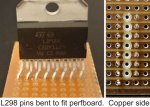jedynakiewicz
Senior Member
I have been using L293D driver ICs to operate small DC motors. I need to increase the current with some new motors and I intend substituting SN754410 chips for the L293D chips. I understand that this is a direct one-for-one substitute but with a higher current rating. The L293D drivers have built-in back-EMF protection diodes and the structural schematic in the datasheet (page 2) (http://www.rapidonline.com/pdf/82-0203.pdf) for the SN754410 appears to show that these are present in this chip also. The application circuit diagram shows external protection diodes however (datasheet page 6). Could the experts enlighten me as to what I actually need to do to power 12v 800mA DC motors (brushed) with these chips? Do I need the external protection diodes? If I do, what diode is recommended?

